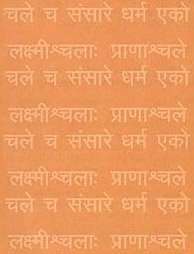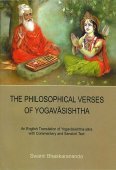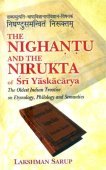Sanskrit: 5 definitions
Introduction:
Sanskrit means something in Buddhism, Pali, Hinduism, Sanskrit, the history of ancient India. If you want to know the exact meaning, history, etymology or English translation of this term then check out the descriptions on this page. Add your comment or reference to a book if you want to contribute to this summary article.
Images (photo gallery)
(+128 more images available)
In Hinduism
Mīmāṃsā (school of philosophy)
Source: Srimatham: Mīmāṃsa: The Study of Hindu ExegesisSanskrit.—According to Mīmāṃsa the meaning (artha) of Sanskrit words is intrinsic to them by their very nature and not dependant upon human agency—i.e. The meaning is not dependant upon the collective decision of people. If this were not so, we would have an “Alice in wonderland” situation where words mean whatever the speaker wants then to mean—in which case communication becomes impossible. Even if we accept this as given—there is still the compounding problem of interpretation in translation—every translator also acts wittingly or unwittingly as an interpreter of the message, and because every Sanskrit word has at least 10 different meanings every translator has interpreted the text according to their own agenda based upon:—
- svabhāva—nature
- bhūmika —level of attainment or expertise
- adhikāra —authority to interpret or to explain the subject matter.

Mimamsa (मीमांसा, mīmāṃsā) refers to one of the six orthodox Hindu schools of philosophy, emphasizing the nature of dharma and the philosophy of language. The literature in this school is also known for its in-depth study of ritual actions and social duties.
In Buddhism
Mahayana (major branch of Buddhism)
Source: Kunpal: Shantideva's Bodhisattva-charyavataraSanskrit is considered the most important (among the 4 four great and special canonical languages) and is known as the divine language [lha’i skad], the language that all buddhas of the three times spoke in the past, are speaking in the present and will speak in the future.

Mahayana (महायान, mahāyāna) is a major branch of Buddhism focusing on the path of a Bodhisattva (spiritual aspirants/ enlightened beings). Extant literature is vast and primarely composed in the Sanskrit language. There are many sūtras of which some of the earliest are the various Prajñāpāramitā sūtras.
General definition (in Buddhism)
Source: Buddhist Door: GlossaryBrahma letters. The classical Aryan language of ancient India, systematized by scholars. With the exception of a few ancient translations probably from Pali versions, most of the original texts in Buddhism used in China were Sanskrit.
India history and geography
Source: Cologne Digital Sanskrit Dictionaries: Indian Epigraphical GlossarySanskrit.—Anglicised form of Saṃskṛta, the name of the sacred language of the Indians. Note: sanskrit is defined in the “Indian epigraphical glossary” as it can be found on ancient inscriptions commonly written in Sanskrit, Prakrit or Dravidian languages.
Source: Singhi Jain Series: Ratnaprabha-suri’s Kuvalayamala-katha (history)Sanskrit refers to one of the four major languages prevalent in ancient India, according to the 8th-century Kuvalayamālā written by Uddyotanasūri, a Prakrit Campū (similar to Kāvya poetry) narrating the love-story between Prince Candrāpīḍa and the Apsaras Kādambarī.—There is a mention of four major languages, namely, Sanskrit, Prakrit, Apabhramsha and Paishachi; and during the 8th century, vast body of Apabhramsha literature appears to have been already produced. The Paishachi language seems to have been represented by the Bṛhatkathā which had survived in its original form upto the time of Uddyotanasūri. This appears to be very probable since the original Paiśācī Bṛhatkathā was known to Kṣemendra who based his Sanskrit version on it.

The history of India traces the identification of countries, villages, towns and other regions of India, as well as mythology, zoology, royal dynasties, rulers, tribes, local festivities and traditions and regional languages. Ancient India enjoyed religious freedom and encourages the path of Dharma, a concept common to Buddhism, Hinduism, and Jainism.
See also (Relevant definitions)
Starts with: Sanskrit drama, Sanskrit literature, Sanskrit poets, Sanskrit-brihati.
Ends with: Loukik-sanskrit.
Full-text (+112246): Bala, Vaya, Sara, Atthiya, Accha, Jaya, Aha, Java, Vatta, Ajja, Gahaṇa, Vaha, Sama, Atta, Payara, Dhara, Samia, Majja, Gaha, Kaccha.
Relevant text
Search found 338 books and stories containing Sanskrit; (plurals include: Sanskrits). You can also click to the full overview containing English textual excerpts. Below are direct links for the most relevant articles:
Maha Prajnaparamita Sastra (by Gelongma Karma Migme Chödrön)
Part 4 - Conditioned dharmas cannot have the three marks (lakṣaṇa) < [Chapter I - Explanation of Arguments]
Part 3 - The Prajñāpāramitāstotra < [Chapter XXIX - The Virtue of Wisdom]
Preliminary note (3): Explanations on the aṅgas < [Part 2 - Hearing the twelve-membered speech of the Buddha]
The Matsya Purana (critical study) (by Kushal Kalita)
Part 2.1a - The Solar Dynasty < [Chapter 3 - Historical aspects in the Matsyapurāṇa]
Part 1a - Note on Architecture (vāstu) < [Chapter 7 - Art and Architecture in the Matsyapurāṇa]
Sanskrit, The World’s Oldest Spiritual & Scientific < [July – September, 2008]
Is Sanskrit an Original Language? < [April – June, 1998]
Sanskrit Culture - Its Value < [July-September, 1928]
Satirical works of Kshemendra (study) (by Arpana Devi)
6. Synonymous Word(s) in Sanskrit for Satire < [Chapter 1 - Introduction]
Vishnudharmottara Purana (Art and Architecture) (by Bhagyashree Sarma)
1.2. Characteristic Features of Sanskrit Drama < [Chapter 3 - Drama and Dance]
1.3. Elements of Drama (g): Characters < [Chapter 3 - Drama and Dance]
7(g): Role of Eyes in Portrait Created in the Context of Painting < [Chapter 5 - Painting and Image Making]
Bhishma Charitra (by Kartik Pandya)
Related products
(+52 more products available)











